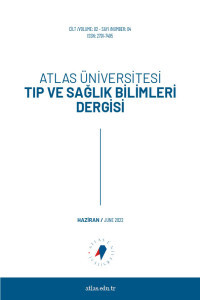HEMATOONKOLOJİDE YAĞLI KARACİĞER (HEMATOLOJİK MALİGNİTELERDE KEMOTERAPİ SONRASI YAĞLI KARACİĞER HASTALIĞI)
kemoterapi ile ilişkili hepatosteatoz, hematolojik maligniteler, alkolsüz yağlı karaciğerhastalığı
___
- Vauthey JN, Pawlik TM, Ribero D,Wu TT, Zorzi D, Hoff PM et al. Chemotherapy regimen predicts steatohepatitis and an increase in 90-day mortality after surgery for hepatic colorectal metastases. J Clin Oncol 2006;24: 2065–2072.
- Parikh AA, Gentner B,Wu TT, Curley SA, Ellis LM, Vauthey JN. Perioperative complications in patients undergoing major liver resection with or without neoadjuvant chemotherapy. J Gastrointest Surg 2003; 7: 1082–1088.
- Marchesini G, Bugianesi E, Forlani G, Cerrelli F, Lenzi M, Manini R et al. Nonalcoholic fatty liver, steatohepatitis, and the metabolic syndrome. Hepatology 2003; 37: 917–923.
- Hamaguchi M, Kojima T, Takeda N, Nakagawa T,Taniguchi H, Fujii K et al. The metabolic syndrome as a predictor of nonalcoholic fatty liver disease. Ann Intern Med 2005; 143: 722–728.
- Pawlik TM, Olino K, Gleisner AL, Torbenson M, Schulick R, Choti MA. Preoperative chemotherapy for colorectal liver metastases: impact on hepatic histology and postoperative outcome. J. Gastrointest. Surg. 2007; 11: 860–8.
- Bilchik AJ, Poston G, Curley SA, Strasberg S, Saltz L, Adam R et al. Neoadjuvant chemotherapy for metastatic colon cancer: a cautionary note. J. Clin. Oncol.2005; 23: 9073–8.
- Zeiss J, Merrick HW, Savolaine ER,Woldenberg LS, Kim K, Schlembach PJ. Fatty liver change as a result of hepatic artery infusion chemotherapy. Am J Clin Oncol 1990;13: 156–160.
- Peppercorn PD, Reznek RH,Wilson P, Slevin ML, Gupta RK. Demonstration of hepatic steatosis by computerized tomography in patients receiving 5-fluorouracil-based therapy for advanced colorectal cancer.Br J Cancer 1998; 77: 2008–2011.
- Abboud G, Kaplowitz N. Drug-induced liver injury. Drug Saf. 2007;30(4):277-94.
- De Valle MB, Av Klinteberg V, Alem N, Olsson R, Björnsson E. Drug-induced liver injury in a Swedish University hospital out-patient hepatology clinic. Aliment Pharmacol Ther. 2006 Oct 15;24(8):1187-95.
- Firneisz G. Non-alcoholic fatty liver disease and type 2 diabetes mellitus: The liver disease of our age? World J Gastroenterol. 2014 Jul 21;20(27):9072-9089. doi: 10.3748/wjg.v20.i27.9072.
- Assy N, Kaita K, Mymin D, Levy C, Roser B, Minuk G. Fatty infiltration of liver in hyperlipidemic patients. Dig Dis Sci. 2000;45:1929–1934.
- Nseir W, Mograbi J, Ghali M. Lipid-lowering agents in nonalcoholic fatty liver disease and steatohepatitis: human studies. Dig Dis Sci. 2012 Jul;57(7):1773-81.doi: 10.1007/s10620-012-2118-3
- Scheig R. Evaluation of tests used to screen patients with liver disorders. Prim Care. 1996;23:551–560.
- Tanaka N, Tanaka E, Sheena Y, Komatsu M, Okiyama W, Misawa N, et al. Useful parameters for distinguishing nonalcoholic steatohepatitis with mild steatosis from cryptogenic chronic hepatitis in the Japanese population. Liver Int. 2006;26:956–963.
- Mathiesen UL, Franzen LE, Fryden A, Foberg U, Bodemar G. The clinical significance of slightly to moderately increased liver transaminase values in asymptomatic patients. Scand J Gastroenterol. 1999;34:85–91
- Thamer C, Tschritter O, Haap M, Shirkavand F, Machann J, Fritsche A, et al. Elevated serum GGT concentrations predict reduced insulin sensitivity and increased intrahepatic lipids. Horm Metab Res. 2005;37:246–251.
- Chen Z, Han CK, Pan LL, Zhang HJ, Ma ZM, Huang ZF, et al. Serum Alanine Aminotransferase Independently Correlates with Intrahepatic Triglyceride Contents in Obese Subjects. Dig Dis Sci. 2014 Oct;59(10):2470-6. doi: 10.1007/s10620-014-3214-3
- Bower M, Wunderlich C, Brown R, Scoggins CR, McMasters KM, Martin RC. Obesity rather than neoadjuvant chemotherapy predicts steatohepatitis in patients with colorectal metastasis. Am J Surg. 2013 Jun;205(6):685-90. doi: 10.1016/j.amjsurg.2012.07.034
- Brouquet A, Benoist S, Julie C, Penna C, Beauchet A, Rougier P, Nordlinger B. Risk factors for chemotherapy associated liver injuries: a multivariate analysis of a group of 146 patients with colorectal metastases. Surgery. 2009 Apr;145(4):362-71. doi: 10.1016/j.surg.2008.12.002
- Başlangıç: 2021
- Yayıncı: İSTANBUL ATLAS ÜNİVERSİTESİ
Raim ILIAZ, Filiz AKYÜZ, Aslı ÖRMECİ, Umut AKYÜZ, Kadir DEMİR, Fatih BEŞIŞIK, Mine GÜLLÜOĞLU, Sabahattin KAYMAKOĞLU
İNTRAOPERATİF POZİSYONA BAĞLI NADİR BİR KOMPLİKASYON: ŞALAZYON
Naime YALÇIN, Ayça Sultan ŞAHİN
Derya SİVRİ AYDIN, Ahmet ÇETİN
Nagehan Didem SARI, Gülhan EREN, Gülşen YÖRÜK, Ayşe İNCİ
DİŞ HEKİMLİĞİ GÜNLÜK PRATİĞİNDE KARACİĞER YETMEZLİĞİ OLGULARINDA ANTİBİYOTİK TEDAVİSİNİN YÖNETİMİ
